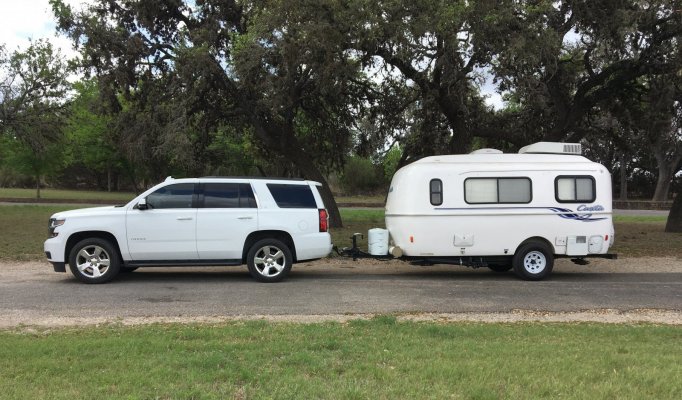Hello, new member. I have a 2011 LTZ Tahoe with tow package. I bought this in 2020 to tow 4 wheelers and such. I have never had a trailer with brakes. Just bought a 2011 travel trailer, 22" 3900 lbs. Towed it home with just my ball hitch. I purchased a E2 load distribution system. In the instructions it says: Tow vehicle “auto-level” systems should also be disabled or turned off. If your tow vehicle is equipped with air bags, we recommend that you inflate them to the pressure you are expecting to tow with before setting up the hitch. Inflating them after hitch set up changes the relationship between tow vehicle and trailer, and can reduce the amount of weight distribution and sway control you get from your hitch.
I know the Tahoe has a compressor, I can see it and hear it on start-up. It sits so high in the rear I had to buy an extra long shank to get the ball down to the correct height.
I have questions. I'm not sure if it has air shocks or air bags. If it has air bags how do I inflate them to the pressure I am expecting to tow with as indicated in the instructions? How do I even know what the PSI in it is? Do I need to disable the ALS to use the load leveler system? If so, is it possible to just pull the fuse for that? If I do disconnect it, do I leave it disconnected the whole time I'm trailering? Do I need to reconnect it when I unhook the trailer, in case we want to go somewhere? If I disconnect it, how does the air leave the system before I can install the load leveling system? Or, do I just ignore the instructions and hook it up where the ALS has it adjusted? I want myself and everyone else on the road to be safe. Never knew it could get so complicated just to pull a trailer. I will ask Fastway Trailer, the maker of the hitch as well. I'm a Yamaha forum member so I know the type of excellent advice that can come from others. Any Tahoe owners with load leveling systems? Appreciate any and all assistance.
I know the Tahoe has a compressor, I can see it and hear it on start-up. It sits so high in the rear I had to buy an extra long shank to get the ball down to the correct height.
I have questions. I'm not sure if it has air shocks or air bags. If it has air bags how do I inflate them to the pressure I am expecting to tow with as indicated in the instructions? How do I even know what the PSI in it is? Do I need to disable the ALS to use the load leveler system? If so, is it possible to just pull the fuse for that? If I do disconnect it, do I leave it disconnected the whole time I'm trailering? Do I need to reconnect it when I unhook the trailer, in case we want to go somewhere? If I disconnect it, how does the air leave the system before I can install the load leveling system? Or, do I just ignore the instructions and hook it up where the ALS has it adjusted? I want myself and everyone else on the road to be safe. Never knew it could get so complicated just to pull a trailer. I will ask Fastway Trailer, the maker of the hitch as well. I'm a Yamaha forum member so I know the type of excellent advice that can come from others. Any Tahoe owners with load leveling systems? Appreciate any and all assistance.


